After the sun goes to sleep, the stars come out to play—and with a lantern, you can too. But the lanterns on this list aren’t the old-school variety you might immediately think of (well, except for this one and this one). These picks have LEDs and ridiculous brightness. Some have solar panels so they can soak up the sun’s rays for extra run time, and others have built-in power packs to charge your devices. There’s even one you can manually crank for more light after the batteries peter out.
When choosing a lantern, consider what activities you'll be using it for, be it camping, backpacking or weathering a potential power outage at home. Then decide what features you want. This can include "fun" features like colorful light settings or functional ones like waterproofing. Finally, read on to find the light for you. It’s time to banish darkness and keep the adventures rolling.
Test Results
Find our quick recommendations here or scroll to read the full reviews.
- Best Lantern for Emergencies & REI Co-op Editors' Choice Award Winner: Goal Zero Lighthouse 600 Lantern & USB Power Hub
- Best Lantern for Backpacking & REI Co-op Editors' Choice Award Winner: LuminAID Max Quick Inflate Solar Lantern with Phone Charger
- Best Miniature Lantern: Black Diamond Moji R+ Lantern
- Best Lantern for Car Camping: Coleman Classic Recharge 800 Lumens LED Lantern
- Best String Lights: BioLite Luci 44' Solar String Lights with Detachable Power Hub
- Best Gas-Powered Lantern: Coleman Powerhouse Dual Fuel Lantern
Other Top Performers
Best Lantern for Emergencies & Editor’s Choice Award Winner
Goal Zero Lighthouse 600 Lantern & USB Power Hub
Score 98
Maximum brightness 600 lumens
Average run time High
Battery Rechargeable 5200 mAh lithium ion NMC
Weight 1 lb. 1.6 oz.
One lantern made it to our tester/first responder’s list of favorites: the Lighthouse 600 from Goal Zero. A top scorer in every metric that matters, the Lighthouse 600 has specs that belie its compact dimensions. It’s roughly the size of a coffee mug when its collapsible legs are folded, yet it emits a whopping 600 lumens. That’s enough to illuminate most tent sites, the front of a car being jumped back to life or a family room during an unexpected blackout. One tester set up the Lighthouse 600 at their cook station while car camping at Gross Reservoir outside Boulder, Colorado, and it provided enough ambient light for her pal to pitch their tent 50 feet away without a headlamp.
The simplicity and battery-longevity of the Lighthouse 600 is another hallmark. From its single dial, you can fire up both sides of the lantern for 360-degree light or just one for more directional light (like if you wanted to illuminate your tent repair without waking up your neighbors), as well as adjust brightness. The lantern also has a USB port for plugging in and juicing up other devices like a phone, headlamp or portable battery pack from its power stores. Its own integrated USB charger wraps around its middle, so you never have to dig for the cord at the bottom of your pack.
Its three charging methods—including one that doesn’t require anything more than a little muscle power—are what make this lantern a top pick for emergency situations. One of our testers deployed the Lighthouse 600 on a winter blackout in northern New England during which she lost power for more than a week. This lantern kept shining for three full winter days before petering out—and it only took a dedicated arm workout to power it back on. That’s right: Pop the lever out of the top of the lantern and start cranking for a mechanical boost to the battery. (Goal Zero calls it a 10-to-1 ratio: 10 minutes of its lowest-level light for every 1 minute of cranking.) It’s a great insurance policy against a dead battery, making this lantern a versatile choice for emergency kits or bug-out bags. The Lighthouse 600 also pairs neatly with Goal Zero’s suite of solar panels, so it can recharge via UV rays if connected.
Physical features are a rarity at this weight, but the Lighthouse 600 does have a metal, swinging handle, which makes it easy to carry or pop on a sturdy tree branch or tarp line. Buy here.
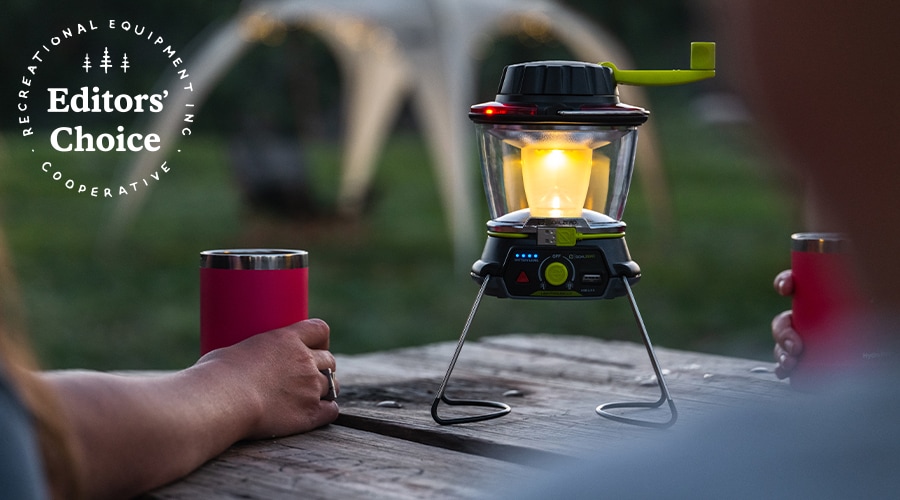
Bottom Line: If you’re looking for a dependable lantern that can provide reassurance for unexpected situations, you can’t do better than the Goal Zero Lighthouse 600, which is bright, easy to use and packed with helpful features.
Testing Stats:
- Nights out: 30
- Testing states: California, Colorado, Idaho, Maine, Montana, Nevada New Hampshire and Utah
- Best Testing Story: “When we’re gearing up for day three of a week-long power outage in rural Maine, we value all the light we can get. This lantern shone as our beacon as we helped the local fire department shovel out our neighbors and welcomed us home where dinner was waiting for us — thanks to a propane stove and the light cranked up from the Goal Zero Lighthouse. We even charged our phones with it at night, so we could keep up with the local weather throughout that crazy week.”
Best Lantern for Backpacking & Editor’s Choice Award Winner
LuminAID Max Quick Inflate Solar Lantern with Phone Charger
Score 97
Maximum brightness 200 lumens
Average run time 3–5 hours (turbo), 6–8 hours (high), 12–16 hours (medium), 44–50 hours (low), 60–72 hours (flashing)
Batteries Rechargeable 2000 mAh lithium ion
Weight 12.5 ounces
OK, backpackers, hear us out. We know weight and space are of the essence, so a lantern may seem like overkill when you already have a headlamp in your kit. But the upgraded LuminAID Max Quick Inflate Solar Lantern with Phone Charger (previously called the LuminAID PackLite Max 2-in-1 Phone Charger) will convince you otherwise—and it saves you the weight of a battery pack too.
As a lantern, the waterproof Max Quick Inflate delivers up to 200 lumens via five modes. Hang the tissue box-size lamp from a tree to illuminate small campsites or affix it to the tent ceiling for visibility when changing, reading or producing epic night photography. The Max Quick Inflate can run for up to 50 hours on the “low” setting, which is why our testers love it for multiday hikes and hut trips. Best part? The lantern has a built-in solar panel, so you have a backup if your batts die.
Or harness the sunshine and use the Max Quick Inflate as a charging station. A built-in USB port allows you to plug in and juice up a phone, headlamp or camera. One tester appreciated the versatility when his phone died on a backcountry ski adventure around New Hampshire’s Tuckerman Ravine on Mount Washington. “Even after powering up my phone, the Max Quick Inflate had enough in the tank for a little lantern-light après in the parking lot,” he says.
Back to weight and space: If we haven’t convinced you yet, consider that the versatile Max Quick Inflate weighs less than a pound and collapses to about the size of a Rite-in-the-Rain notebook, stowing easily in a pack’s top lid. Did we mention that this lantern self-inflates, requiring no huffing and puffing to blow up your light? One Alaska-based guide, who brought it on a two-week ski-mountaineering trip, called it “the best weight I could carry.” Buy here.
Bottom Line: Trekkers will appreciate the versatility of the LuminAID Max Quick Inflate Solar Lantern with Phone Charger, a portable lantern and charging station worth its ounces.
Testing Stats:
- Nights out: 44
- Testing locations: Alaska, Colorado, Iowa, Maine, Massachusetts, Montana, New Hampshire, Wyoming, and Vermont; Alberta, British Columbia and Yukon Territory, Canada
- Best testing story: One tester discovered that the Max Quick Inflate makes for an OK pillow in a pinch—“not compared to an actual pillow, but to a pile of smelly clothes with pokey zippers,” she says. On a winter ski-mountaineering trip, she’d hang it from the tent ceiling at night for chores like straightening up drying gear, reading topo maps and removing her contact lenses, then she’d take it down, deflate it “just a smidge” and tuck it in the hood of her sleeping bag.
Best Miniature Lantern
Black Diamond Moji R+ Lantern
Score 96
Maximum brightness 200 lumens
Average run time 5 hours (high), 8 hours (medium) 100 hours (low)
Batteries Rechargeable 1500 mAh Li-ion
Weight 2.8 ounces
Looking for a simple lantern that you can clip onto a backpack, toss in a gear hammock or keep handy on your way to the outhouse? Look no further. The Moji R+—a rechargeable version of the popular Moji from Black Diamond, and the newest iteration of the ReMoji—is a little baseball of a lantern with a couple of D-rings for easy lashing. Compared to a previous version, Black Diamond slashed the Moji R+ 's weight nearly in half, doubled the lumens, and increased the run time by dozens of hours. (We lasted 30 hours on high and low.)
The compact Moji R+ sports many of the same settings of a headlamp—maximum brightness, dimmable light, strobe—but with a couple of key differences. For starters, the globe is frosted, which creates soft, ambient light—a pleasant departure from the harsh spotlight effect campers get when hanging a headlamp from the tent ceiling. It also has a rainbow cycle, so you can let it flow through the spectrum like hot tub lighting or stop it on the solid color of your choice (including red light).
The Moji R+ has collapsible hooks, which allow you to string it on anything without a carabiner, while four magnetic dots let you snap it to a fridge or car door when you’re out of the field. It fully charges via USB in less than three hours, and it’s waterproof. Buy here.
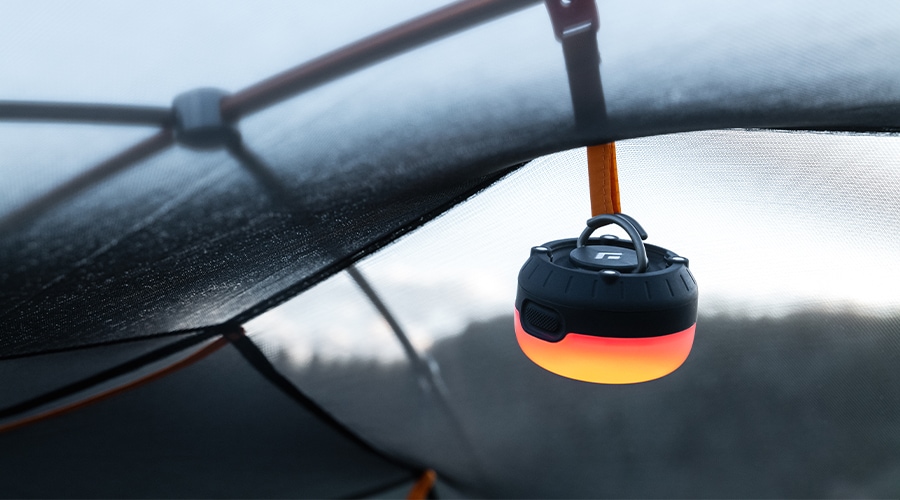
Bottom Line: For a lightweight, compact lantern that can hang just about anywhere, the rechargeable Black Diamond Moji R+ is best in test.
Testing Stats:
- Nights out: 38
- Testing states: Alaska, Colorado, Maine, Massachusetts, Montana, New Hampshire, Vermont, Wyoming and Quebec, Canada
- Best testing story: On a road trip through New England, one Maine-based tester clipped the Moji R+ to her dog’s harness at camp when the sun set each day. The leashed dog, “in his infinite wisdom,” his mom says, took off into the woods on an otherwise routine midnight potty break. “Without the lantern, I wouldn’t have been able to easily spot where he was tangled up with a tree,” says the tester, who then used the Moji R+ to pick her way back to the tent.
Best Lantern for Car Camping
Coleman Classic Recharge 800 Lumens LED Lantern
Score 94
Maximum brightness 800 lumens
Average run time Up to 5 hours (high), 15 hours (medium), 45 hours (low), 45 hours (flashing)
Batteries Rechargeable 4800 mAh lithium-ion battery
Weight 2 lbs. 4.2 oz.
You want the portability of a lantern with the luminosity of a campfire. The good news: You don’t have to choose between the two. When it comes to car camping, you can have it all—with lots of light, a long battery life, and the cozy aesthetic of an old- school lantern. This camp lantern is one of the brightest we tested at 800 lumens, and it withstood the harshest of New England winter blackouts. During a December rainstorm that flooded several New England towns along with Maine’s Sunday River ski resort, widespread power outages threw our testers into on-and-off darkness. On a full charge, this lantern lasted for two full evenings of illumination and recharged quickly from a battery pack on the third night. It even served as a power bank when phone batteries ran low.
Another tester brought this lantern on a long weekend car-camping trip in Moab, Utah, and lit up his campsite each night with ease. “It was the farthest-extending lantern I’ve ever used and extremely handy to clip on a tent pole and play cards under on a snowy night,” he says. Four settings give you the ability to turn it down to create soft mood lighting or dial it up for maximum brightness. A strobe setting can be used to signal help in an emergency.
This lantern packs a punch for its weight (it’s lighter than a can of soup), though it’s not as compact as other lanterns we tested. For its brightness and its stamina, however, we think it’s earned a spot in the car. Buy here.
Bottom Line: Elevate (and illuminate) your car camping experience with this classic, versatile lantern and charging station.
Testing Stats:
- Nights out: 10
- Testing stats: Colorado, Maine, New Hampshire, Utah and Vermont
- Best testing story: “In a winter power outage, we drove out to a friend’s house for what should have been a holiday party. Instead, we had a campfire on one side of the yard and made cocoa by lantern light on the other, thanks to the Coleman Classic Recharge. We kept a speaker plugged into the Recharge to play Christmas carols for the evening. Talk about an all-in-one!”
Best String Lights
BioLite Luci 44' Solar String Lights with Detachable Power Hub
Score 92
Maximum brightness 140 lumens
Average run time Up to 8 hours (high), up to 24 hours (medium), up to 40 hours (low)
Batteries Rechargeable 4000 mAh lithium-ion
Weight 1 lb. 10.2 oz.
A strand of lights might not be an obvious choice for camping, but it should be. Instead of pooling the light in one spot like a traditional lantern, string lights let you spread it out or even encircle an area you want to brighten. Our favorite for the occasion is the BioLite Luci Solar String Lights + Detachable Power Hub, an 44-foot-long strand decorated with 20 nodes. This updated version also has a detachable power hub, so you can juice it up over a multi-day camping trip without removing your string lights from tree limbs. The effect is A+ ambiance with a lot less work.
Testers noted the durable nylon cord rarely tangles, easily wrapping up around the plastic base and telescoping in when not in use. That base holds a small solar panel, which can power the lights for more twinkling when the battery runs out. BioLite claims 16 hours in direct sun can fully charge the device. Testers had no problem after a day or two (this varied based on the amount of direct sunlight) of the lights sitting on a vehicle dashboard in New England. A built-in USB port means you can also power up other gadgets with the hub, making you the campsite superstar.
The Luci Solar String Lights + Detachable Power Hub is a slam dunk for car camping: string it around a picnic table or tent vestibule. Though a little bulky for ounce-counting backpackers, it can fit in a pack if you want to up the ambience of your backcountry site. It’s less than two pounds and about the size of a Tupperware container, so you can easily slide it in the brain of a backpack or lash it to the top lid for on-the-go solar charging.
Our testers also lauded its versatility in more casual pursuits. One tester brightened up her tailgate for a season of post-adventure hangs and sunset missions. “Best night: Hot drinks and an apple crumble were enjoyed on the Maine—New Hampshire state line under the glow of these lights,” she wrote on her feedback form. She couldn’t have been happier at the ability to Pinterest-out her truck. Buy here.
Bottom Line: The BioLite Luci Solar String Lights with Detachable Power Hub are a fun and flirty way to light up your space and charge your devices at the same time.
Testing Stats:
- Nights out: 22
- Testing stats: Alaska, Colorado, Maine, Minnesota, New Hampshire, Vermont and Washington
- Best testing story: While testing this string of lights in the snowy woods of New Hampshire last winter, our tester found a new friend in the form of a barn owl perched on a nearby fence. “I flicked through the high, medium and low power levels to see what would happen, and the owl seemed to dig it by hooting softly every time the light changed,” says our tester.
Best Gas-Powered Lantern
Coleman Powerhouse Dual Fuel Lantern
Score 88
Maximum brightness 800 lumens
Average run time up to 5 hours (high), up to 20 hours (low)
Power source White gas or unleaded gasoline (sold separately)
Weight 4 lbs. 10.4 oz.
Light up your backcountry hut, ice-fishing shed or backyard picnic the old-fashioned way with the Powerhouse Dual Fuel Lantern from Coleman. Why a gas-powered lantern, you ask? For starters, it will be your best friend in extreme-cold conditions, which can drain batteries in other lanterns faster than you can say “nor’easter.” (Just ask the Maine-based testers who relied on it during a weeklong power outage—thankfully, it would have to be pretty darn cold for your gas to freeze.) Plus, weather is less likely to affect this lantern compared to other gas-powered options thanks to glass that protects the flame from strong winds, snow and rain.
Top off the attached fuel canister with white gas or car-grade unleaded gasoline, then enjoy the warm glow of the flame and the nostalgia of gas-powered light. An adjustable dial lets you soften the intensity to reading-light levels or fire it up to illuminate your whole campsite.
Of course, there are a few reasons the ol’ Coleman is a classic. Most obviously, some may find the hissing sound of the gas to be too loud (others may find it nostalgic). And, as you’d expect from gear originally developed in 1914, it’s heavy and less intuitive than others on this list. To use it, screw the lantern atop the fuel canister, tie on the mantles, ignite the gas flow, lower the glass and attach the lid. (Don’t worry, instructions are included.) Buy here.
Bottom Line: For a hardy, classic lantern that won’t leave you hanging in extreme weather, the gas-powered Coleman Powerhouse Dual Fuel lantern lived up to testers’ expectations.
Testing Stats:
- Nights out: 9
- Testing states: Maine, Massachusetts and New Hampshire
- Best testing story: Two winter holiday seasons in a row, Mainers have had wicked storms roll through. But thanks to the Coleman Powerhouse Dual Fuel, the path was always brightly lit. One tester illuminated his walkway and driveway on a sleeting morning without power to plow out a path to reach town. This lantern lit up the entryway again when he returned home to no electricity that night. “It was the only thing that didn’t fail in single digits in New England—that’s wicked tough.”
Other Top Performers
Honorable Mention
Nite Ize Radiant 400 LED Lantern
Score 85
Maximum brightness 400 lumens
Average run time 26 hours (high), 112 hours (medium), 795 hours (low)
Batteries 3 D-cell
Weight 11.6 ounces
If you want something that goes and goes and goes, the Nite Ize Radiant 400 may be for you. This thing runs for 26 hours on maximum settings and a ridiculous 795 hours (or nearly five weeks; not a typo) on its lowest power—easily the longest single run time in our test. It can spit out 400 lumens of light (enough to illuminate small campsites), and its three brightness settings are just basic enough to be functional—high, medium, low. Our testers praised the intuitive single button and the carabiner clip on the top handle of the Radiant 400, easily snapping the lantern to a line, tree limb or gear loop. So, what are the drawbacks? Well, this lantern isn't rechargeable and more power to you if you keep D-cell batteries on hand. It's also a bit heavy and bulky (the size of an ice cream pint) for backpacking—when the obscene run time would be a boon. Buy here.
Buying Advice
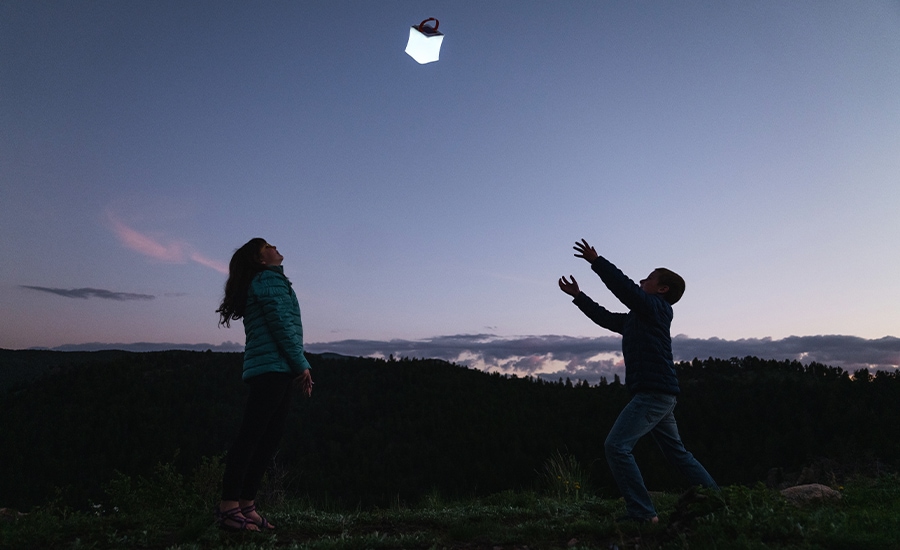
When choosing the perfect lantern for you, consider power source, brightness, features, weight and portability (especially if you intend to play backcountry two-square with your lantern).
Power Source
Batteries—of one kind or another—make most modern lanterns tick. The majority of lanterns run on alkaline or rechargeable lithium-ion batteries, and both have their benefits.
A lantern that runs on disposable batteries like the Nite Ize Radiant 400, which uses three D-cells, is more predictable. When the lantern dies, pop in new ones. (You are carrying spares with you, right?) Alkaline batteries are sold widely, and they often hold their charge better over time if unused, making them great for emergency-kit lanterns.
A lantern that runs on a rechargeable lithium-ion battery, on the other hand, tends to be more versatile. You can fully juice it and start off every trip at 100% by plugging it into a power source. Such lithium-ion batteries also tend to operate better than alkaline batteries in colder conditions, and they hold a more consistent brightness as they die. And if your lantern offers a manual way to recharge the batteries—for instance, the Goal Zero Lighthouse 600 Lantern can be revived using a hand crank—it can also make a great addition to an emergency kit. The ability to rely on manual charging in emergencies can make or break a situation.
In this guide, most lights use a rechargeable lithium-ion battery, and each can be charged through an external power source via USB. Some can be juiced multiple ways, which helps them last even longer away from a wall outlet or electric power source: The Goal Zero Lighthouse 600 can also be charged mechanically with a hand crank, while the LuminAID Max Quick Inflate Solar Lantern with Phone Charger and BioLite Luci 44' Solar String Lights with Detachable Power Hub can also be charged with solar energy.
In this guide, one light runs on fuel instead of batteries: the Coleman Powerhouse Dual Fuel Lantern.
Brightness
Lumens, which correspond to how bright a light is, are often listed in specs as a lantern’s output. The higher the number, the brighter the light in its highest setting.
While some lanterns boast hundreds of lumens, you don’t actually need all that many to see things close at hand. If you’re only using your lantern to create ambiance or look at things close-up, you can get away with 100 lumens or fewer, using something like the Black Diamond Moji R+. (String lights like the BioLite Luci 44’ Solar String Lights with Detachable Power Hub are also great options for this.)
If you want to see a little more—like your cook space, your eating area, or even your entire campsite or hut—brightness is more important. The Goal Zero Lighthouse 600, LuminAID Max Quick Inflate Solar Lantern with Phone Charger and Nite Ize Radiant 400 are more traditional lanterns in this sense.
Features
All lanterns create light, but some can do more. The Black Diamond Moji R+ can cycle through a rainbow of colors, perfect for setting an ambiance or enjoying with young kids. The Goal Zero Lighthouse 600, LuminAID Max Quick Inflate Solar Lantern with Phone Charger and BioLite Luci 44’ Solar String Lights with Detachable Power Hub allow you to charge other devices through built-in USB ports. Decide what additional features or light settings you want before selecting your lantern.
Weight and Portability
Finally, consider if you plan to carry your lantern on backcountry adventures and where you’d like to store it.
On this list, the LuminAID Max Quick Inflate Solar Lantern with Phone Charger and Black Diamond Moji R+ are the best choices for backpackers who want a lightweight lantern that doesn’t consume too much prized space inside a pack.
Each lantern on this list will fit nicely inside a gear bin. Just make sure to store your Coleman Powerhouse Dual Fuel Lantern in a sealed bag to prevent bugs from nesting inside and blocking the fuel/airflow.
How to Choose and Use a Lantern
Methodology
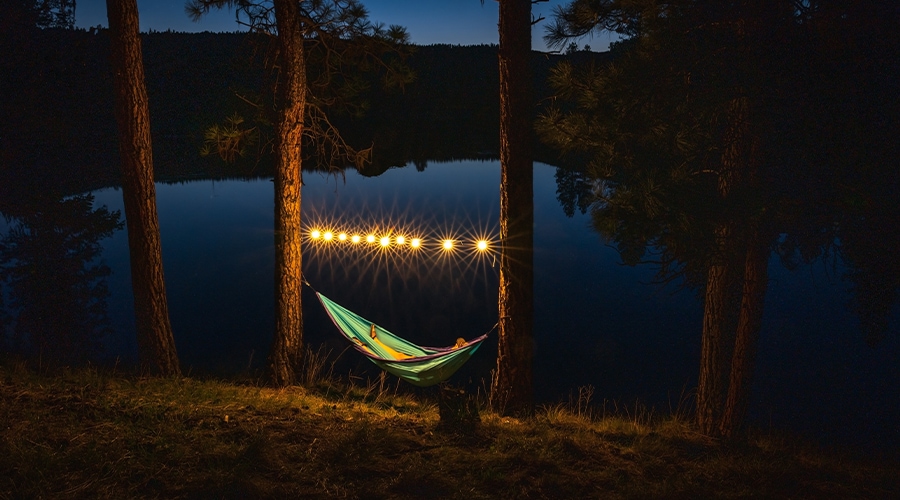
In the final months of 2023, we sent 13 nighttime-loving testers into the field with the best lanterns and string lights available at REI Co-op. They lit up the darkness across the country, from Southeast Alaska (with a whopping three hours of daylight in early spring) to the White Mountains of New Hampshire (just nine hazy hours). They tried out lanterns in tents and huts, as well as backyards and tailgates.
After dozens of nights, our co-op member-testers filled out feedback forms that asked them to evaluate each light's portability, durability, brightness, battery life, features and ease of use. They rated each lantern or string lights on a 100-point scale for each metric; the scores listed here are the averages.
The eight lights featured in this guide received the highest average scores in the test. The Goal Zero Lighthouse 600 Lantern (98) and LuminAID Max Quick Inflate Solar Lantern with Phone Charger (97) received nearly perfect scores all-around, earning our coveted REI Co-op Editors' Choice Awards. The Black Diamond Moji R+ Lantern (96), Coleman Classic Recharge 800 Lumens LED Lantern (94), BioLite Luci 44' Solar String Lights with Detachable Power Hub (92) and Coleman Powerhouse Dual Fuel Lantern (88) scored the next-highest, proving that they are great options in their respective categories.
Lastly, the Nite Ize Radiant 400 LED Lantern (85) scored high in many—but not all—categories, carving out special use cases in their respective niches.
Photography by Andrew Bydlon.
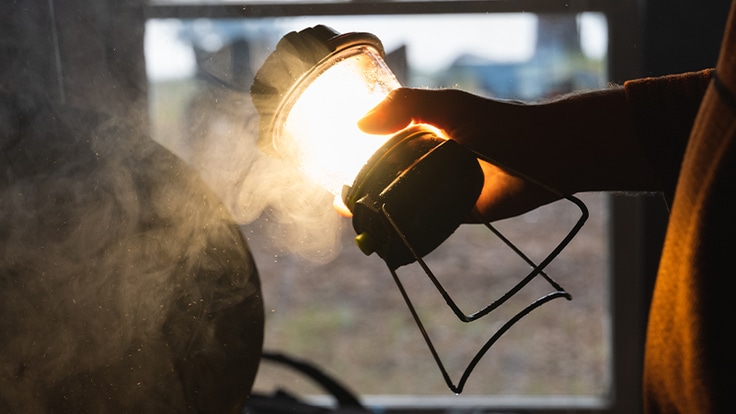




![Max Quick Inflate Solar Lantern with Phone Charger [Phone and lightning charging cable not included]](/media/c8789d87-d278-4e4d-8f7c-5a31d769f21d/?size=440)


















